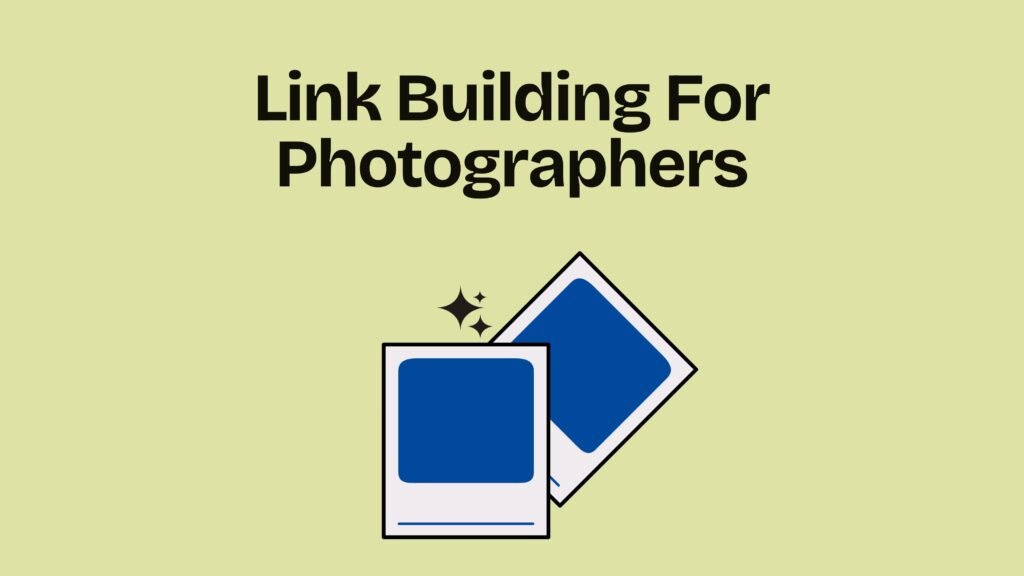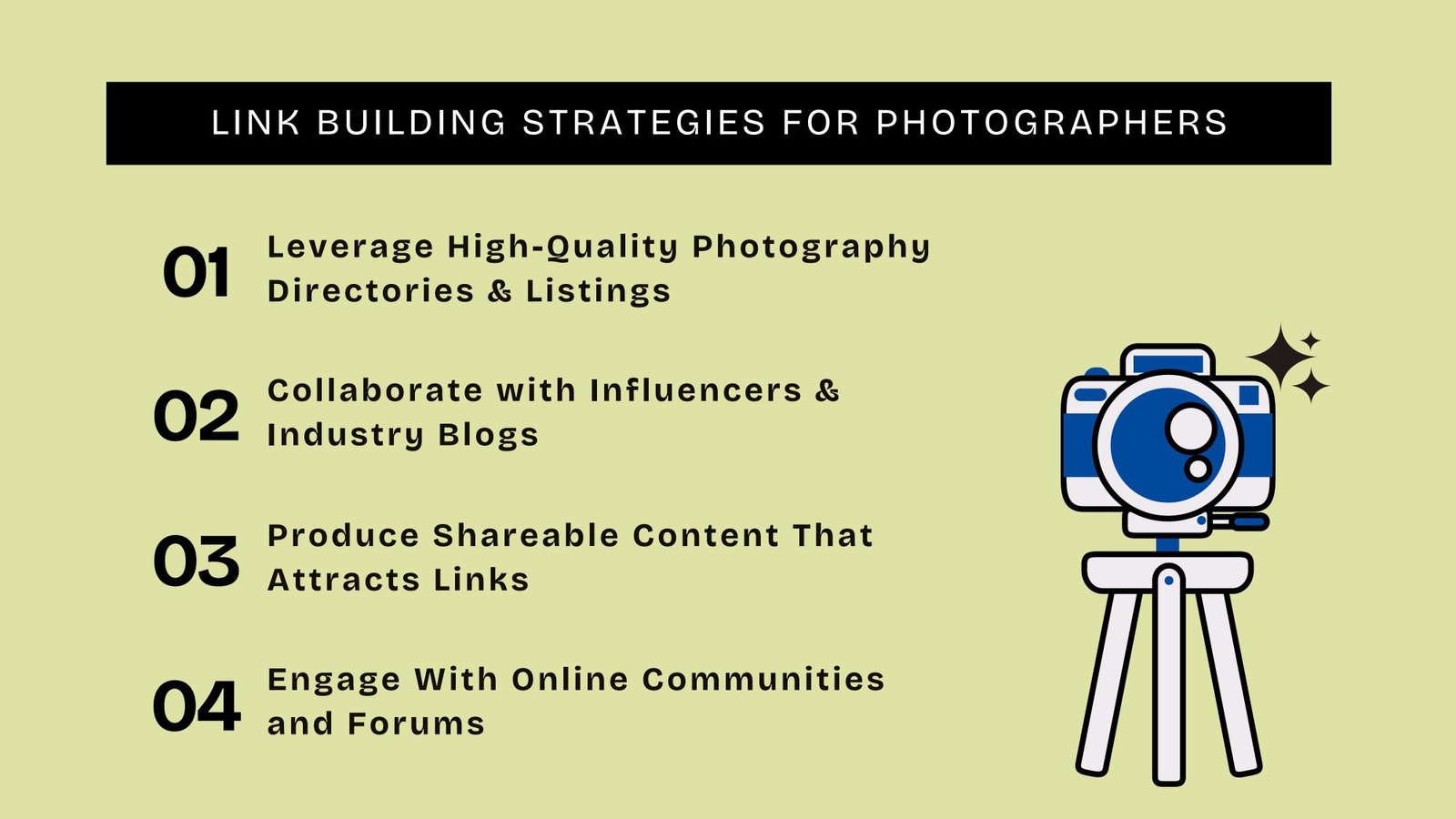
Link building is an essential aspect of digital marketing that can significantly enhance the online presence of photographers. In an era where visual content dominates the internet, photographers must leverage every available tool to stand out in a crowded marketplace. This article, “Link Building For Photographers,” delves into the strategies and benefits of link building, specifically tailored for those in the photography industry.
As a photographer, your portfolio is your most powerful asset. However, even the most stunning images can go unnoticed without proper visibility. This is where link building comes into play. By acquiring high-quality backlinks from reputable websites, photographers can improve their search engine rankings, drive more traffic to their portfolios, and ultimately attract more clients.
The process of link building involves creating valuable content that others want to link to, reaching out to industry influencers, and engaging in collaborations that can lead to mutual benefits. For photographers, this could mean writing guest posts for photography blogs, participating in online forums, or even collaborating with other artists for joint projects. Each of these activities not only enhances your visibility but also establishes your authority in the field.
Moreover, link building is not just about quantity but quality. Search engines like Google prioritize links from authoritative sites, so it’s crucial to focus on building relationships with reputable sources. This can be achieved by consistently producing high-quality content that resonates with your audience and aligns with the interests of potential link partners.
In this article, we will explore various link building techniques that photographers can employ to boost their online presence. From understanding the basics of SEO to implementing advanced strategies, this guide aims to equip photographers with the knowledge and tools needed to succeed in the digital landscape. Whether you’re a seasoned professional or just starting, effective link building can be a game-changer for your photography business.
Why is Link Building For Photographers Important?
Enhances Online Visibility
Link building plays a crucial role in increasing a photographer’s online presence. When reputable websites link to your portfolio or blog, search engines interpret this as a sign of credibility and relevance. As a result, your website ranks higher in search engine results pages (SERPs), making it easier for potential clients to discover your work.
Boosts Search Engine Rankings
Search engines like Google consider backlinks as one of the most significant ranking factors. The more high-quality backlinks you acquire, the better your chances of appearing on the first page of search results. This is especially important for photographers competing in local markets or niche photography styles.
Builds Authority and Credibility
Having links from authoritative websites such as photography blogs, industry magazines, or local business directories enhances your credibility. It signals to both search engines and visitors that your website is trustworthy and worth exploring.
Drives Targeted Traffic
Links from relevant websites attract visitors who are genuinely interested in photography services. For example, a link from a wedding planning blog can direct engaged couples seeking photographers to your site. This targeted traffic increases the likelihood of inquiries and bookings.
Supports Brand Awareness
Consistent link building helps establish your brand within the photography community and beyond. When your work is featured on popular platforms, it increases your exposure and recognition among potential clients and collaborators.
Facilitates Networking Opportunities
Engaging in link building often involves outreach to other photographers, bloggers, and industry influencers. This process fosters relationships that can lead to collaborations, guest posting opportunities, and referrals.
Improves Local SEO
If you operate a local photography business, local backlinks from directories, local blogs, and community websites are vital. They help your website rank higher in local searches, making it easier for nearby clients to find your services.
Cost-Effective Marketing Strategy
Compared to paid advertising, link building is a cost-effective way to generate organic traffic. While it requires time and effort, the long-term benefits include sustained visibility and higher search rankings without ongoing ad spend.
Key Benefits Summary
• Increases website traffic
• Improves search engine rankings
• Builds industry authority
• Attracts targeted clients
• Enhances brand recognition
• Fosters professional relationships
• Supports local SEO efforts
• Offers a cost-effective marketing approach
For photographers aiming to grow their online presence and attract more clients, link building is an essential component of a comprehensive SEO strategy. By earning high-quality backlinks, you not only improve your search engine rankings but also establish your reputation within the photography community and beyond.
Top Strategies For Link Building For Photographers
 In today’s competitive digital landscape, having a stunning portfolio isn’t enough for photographers to stand out. Effective link building can significantly boost your website’s authority, increase traffic, and attract potential clients. But how do you craft an effective link-building strategy tailored specifically for photographers? Let’s explore proven techniques that will help elevate your online presence.
In today’s competitive digital landscape, having a stunning portfolio isn’t enough for photographers to stand out. Effective link building can significantly boost your website’s authority, increase traffic, and attract potential clients. But how do you craft an effective link-building strategy tailored specifically for photographers? Let’s explore proven techniques that will help elevate your online presence.
1. Leverage High-Quality Photography Directories and Listings
One of the simplest yet most impactful ways to build backlinks is by submitting your site to reputable photography directories and local business listings.
• Niche-specific directories: Platforms like 500px, SmugMug Showcase, or PhotoShelter allow you to showcase your work while earning valuable links.
• Local business listings: Ensure you’re listed on Google My Business, Yelp, Bing Places—these not only improve visibility but also provide authoritative backlinks.
2. Collaborate with Influencers & Industry Blogs
The power of influencer collaborations cannot be overstated in the photography world. Partnering with well-known bloggers or respected industry websites opens up opportunities for guest posting and valuable backlinks.
Create Compelling Content
• Offer unique, high-value content that influencers would love to share with their audience. Some content ideas include:
• Tutorials on lighting, framing, or editing
• Behind-the-scenes stories of memorable photo shoots
• Time-lapse videos or transformation series
These types of content not only educate but also entertain and inspire—making them share-worthy.
Sponsor Features or Interviews
Reach out to industry influencers or bloggers for interviews and features. Being the subject of a feature article often includes backlinks to your website or portfolio. These natural mentions can significantly boost both your domain authority and brand awareness.
3. Produce Shareable Content That Attracts Links
Content marketing remains one of the most effective long-term SEO strategies. The key is to create assets that others find valuable enough to reference and share.
High-Value Content Ideas:
Photography Guides: Create detailed how-to articles about camera settings, lighting setups, editing techniques, gear reviews, and more.
Visual Assets: Design infographics about composition rules, statistics about photography trends, or visual comparisons of different lenses. Share free downloadable presets or templates.
Case Studies and Client Stories: Publish real-life success stories of photo sessions or weddings you’ve shot. This builds authority and is often picked up by local news or niche websites.
These content types naturally encourage backlinks because they provide tangible value to readers and fellow photographers.
4. Engage With Online Communities and Forums
Being active in online communities not only helps you connect with fellow creatives but also creates opportunities for organic link building.
Platforms to Join:
• DPReview forums
• Reddit photography subreddits
• Facebook groups dedicated to photography
• Specialized Discord communities
Key Points to Remember:
• Offer genuine, helpful advice without overt self-promotion.
• When relevant, share your work or link to your portfolio or blog.
• Stay consistent in your engagement—this builds trust and authority over time.
5. Utilize Local Events and Workshops to Generate Backlinks
Offline events often translate into online exposure. Participating in local photography exhibitions, wedding expos, or workshops not only builds credibility but can also result in valuable backlinks.
How to Leverage These Events:
Sponsor or speak at events: This often gets you listed (with a link) on the event’s official website.
Write event recaps: Publish blog posts about your experience, which other participants may share and link to.
Collaborate with co-hosts or vendors: Exchange links through content partnerships or guest features.
These activities also help build your local SEO footprint, making you more visible to potential clients in your area.
6. Build Relationships Through Outreach Campaigns
Email outreach remains a core strategy in any successful link-building campaign. As a photographer, your outreach can be tailored to businesses, blogs, or influencers in complementary niches such as wedding planners, local venues, art galleries, or cultural organizations.
Best Practices:
• Personalize each email based on the recipient’s interests and niche.
• Clearly outline mutual benefits and shared audience interests.
• Offer exclusive content like a guest post, tutorial, or photo series.
• Follow up respectfully if you don’t hear back the first time.
• Strategic, value-driven outreach helps you build long-term relationships that often result in repeat backlinks.
Measuring & Analyzing Link Building Success
Tracking the effectiveness of your link-building efforts is essential. It ensures that your time and resources are being spent wisely and helps you adjust your strategy based on what works best.
Key Metrics to Track:
1. Backlink Quantity: Track how many total backlinks your site has. While quantity is a good start, it’s not the most important factor.
2. Referring Domains: Focus on getting links from a variety of different websites. A diverse backlink profile boosts your authority.
3. Domain Authority (DA): This is a metric developed by Moz that estimates how well your site will rank in search results. A higher DA typically indicates better SEO health.
4. Anchor Text Distribution: Ensure your backlinks use varied, natural-sounding anchor text. Overusing exact-match keywords can trigger spam filters.
5. Referral Traffic: Use Google Analytics to track how much traffic comes from backlinks. This indicates which links are providing actual value.
6. Keyword Rankings: Monitor your positions for important keywords like “wedding photographer in [city]” or “best portrait photography.”
7. Conversion Metrics: Ultimately, track leads, inquiries, and bookings that result from referral traffic.
Tools to Help You Monitor Progress
Several SEO tools make it easier to track your metrics and assess the quality of your backlinks:
Google Search Console: View inbound links, index status, and keyword performance.
Ahrefs: Deep backlink analysis, anchor text breakdowns, and referring domain quality checks.
SEMrush: Useful for tracking keyword rankings and competitor backlink strategies.
Moz Pro: Great for domain authority and page authority tracking.
Majestic SEO: Excellent for visualizing trust flow and link neighborhoods.
Use these tools regularly—monthly reviews are ideal—to track your progress and pivot when needed.
A/B Testing and Ongoing Improvement
A/B testing isn’t just for ads and landing pages. You can apply this mindset to link building too.
Ideas to Test:
• Different email templates for outreach
• Varying types of content in guest posts
• Using different anchor texts for the same page
• Testing which platforms (forums, blogs, influencers) give the best ROI
• Document what you’re testing, measure outcomes, and adapt accordingly.
Best Practices for Continuous Improvement
1. Set Clear Goals: Know whether your goal is improving keyword rankings, increasing traffic, or driving leads.
2. Monitor Competitors: Study their backlink profiles using tools like Ahrefs to discover linking opportunities.
3. Assess Link Quality: Prioritize high-authority, relevant websites over quantity.
4. Stay Updated: SEO and link-building best practices evolve. Keep learning.
Common Link Building Mistakes Photographers Should Avoid
Even with the best intentions, many photographers fall into common link-building traps. Avoid these mistakes to ensure your strategy is effective and sustainable.
1. Focusing on Quantity Over Quality
Don’t aim for hundreds of backlinks from low-authority or irrelevant sites. Google values quality over quantity. A few links from authoritative photography sites are far more valuable than dozens from spammy directories.
2. Ignoring Relevance
Relevance matters. Links from unrelated industries can look suspicious and may not pass SEO value. Focus on links from other photographers, wedding planners, local business networks, and photography equipment blogs.
3. Using Black Hat Techniques
Avoid buying links or participating in link schemes. These violate Google’s Webmaster Guidelines and could result in penalties or even deindexing of your site.
Instead, focus on ethical, white-hat strategies like guest blogging, content partnerships, and naturally earned media mentions.
4. Poor Anchor Text Strategy
Anchor text provides context to search engines. Over-optimizing it (e.g., always using the exact same keyword phrase) can trigger spam filters.
Use a mix of anchor types:
• Branded terms (“Jane Doe Photography”)
• Descriptive phrases (“view wedding photography portfolio”)
• Natural text (“check out this photo shoot we did in Italy”)
Frequently Asked Questions
What is link building, and why is it important for photographers?
Link building is the process of acquiring hyperlinks from other websites to your own. It’s crucial because it increases your site’s authority, visibility on search engines, and helps you attract more clients through organic traffic.
How can I find relevant websites for backlinks?
Start by identifying popular photography blogs, directories like Yelp or WeddingWire, art forums, and niche communities. Use SEO tools to analyze competitors’ backlinks for inspiration.
What ethical strategies should I use?
Focus on content creation, guest blogging, influencer outreach, and collaboration with related professionals. Avoid buying links or using link farms.
How long does it take to see results?
It depends on your niche, competition, and consistency. Generally, you’ll start seeing results within 3–6 months of focused effort.
What content attracts the most backlinks?
• Tutorials and how-to guides
• Visual assets like infographics and downloadable presets
• Case studies and client stories
• Interviews with photography experts
• Unique photo series and galleries
Link building for photographers isn’t about shortcuts—it’s about consistent, ethical efforts that add real value. By producing compelling content, engaging with communities, collaborating with others, and monitoring your progress through the right tools, you can steadily grow your online presence and attract more clients.
Remember, quality matters more than quantity. Focus on building genuine relationships, creating valuable resources, and staying consistent. Over time, your hard work will pay off with better search rankings, more organic traffic, and a stronger reputation in the photography industry.
